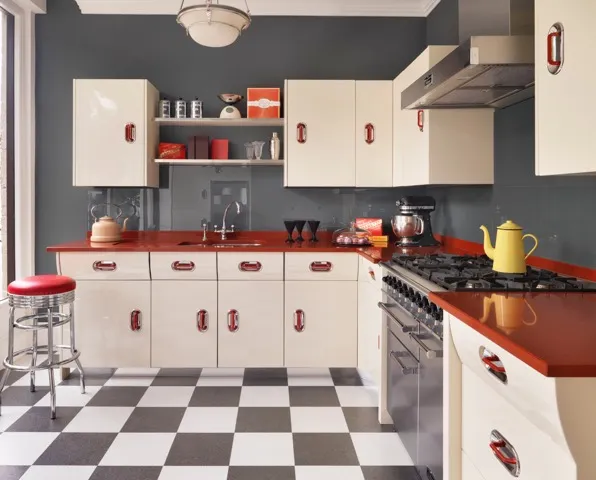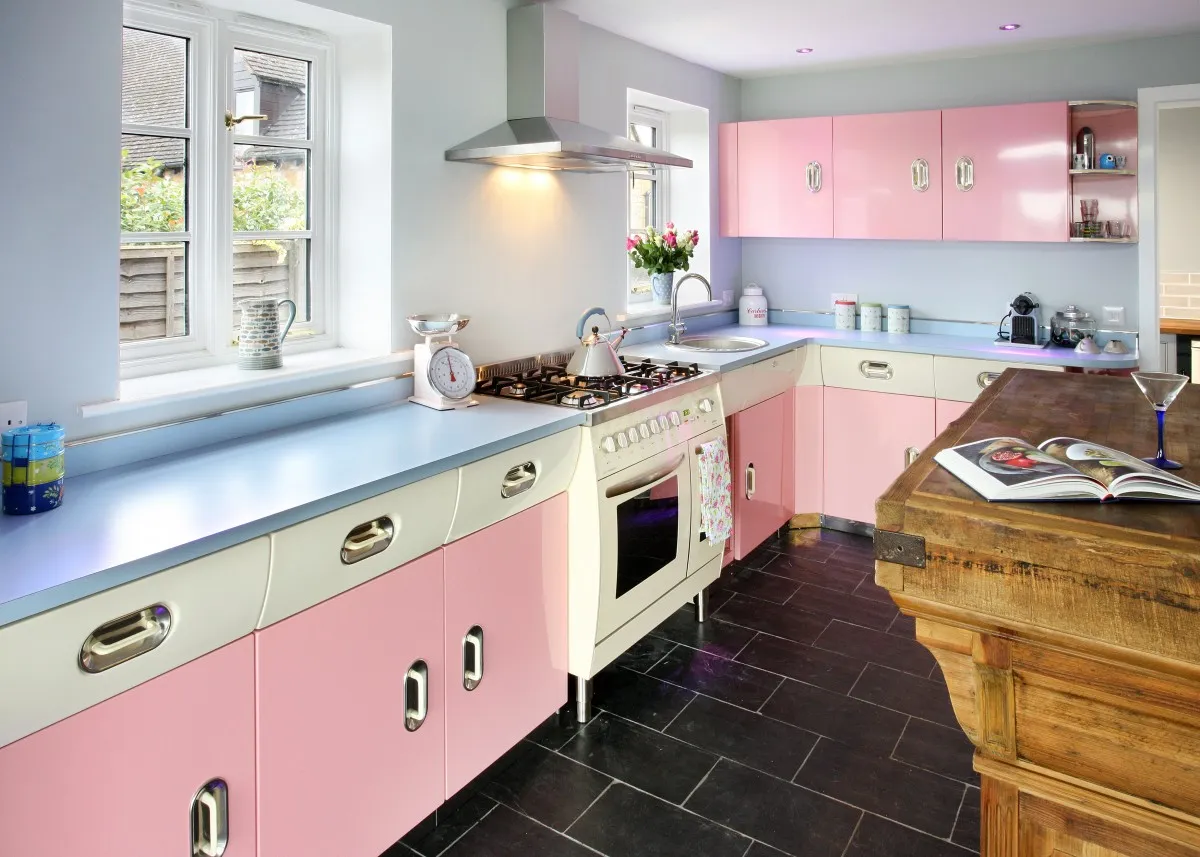H&A blogger Sarah-Jane Hosegood runs the weekly Twitter vintage networking event #vintagefindhour. In her blog for H&A she writes about her most recent finds and fair experiences. This month, she opens the door on an iconic range of retro kitchens, the 'English Rose', and discovers how you can have one too

Rewind back to the 1980s and my childhood home. The house was built in the 1930s and, having been owned by one of the Babycham founders, had undergone a glamorous 1950s makeover funded by Babycham success. Along with carved oak panelling, bespoke furniture, a pearlescent mosaic bathroom and an indoor pool, the house also contained a huge ‘English Rose’ kitchen in red and cream - the height of 1950s interior fashion.
The 'English Rose' was born out of post-war surplus. During World War Two, Constant Speed Airscrews Ltd. (later CSA Industries), a Warwickshire-based engineering firm, made successful trade manufacturing Spitfire aircraft nose cones and parts for Lancaster bombers. Come peacetime however, this left the company with vast amounts of machinery, a large workforce, stockpiles of aircraft grade aluminium and nothing to use them for.
In 1948 the company took what transpired to be a genius decision to diversify into making upmarket fitted kitchens in a style influenced by bold American design – a clever way to use their workforce, expertise, machinery and materials.
The ‘English Rose’ range, as it was named, was one of the first modular fitted kitchens in Britain and came with a range of units made from sturdy aluminium that bolted neatly together to provide maximum use of interior space. It was a mind-boggling innovation compared to the free-standing wooden kitchen furniture of the time.
The materials used meant that the kitchen had a clean and streamlined appearance and the curved drawers have since become icons of retro style. Brightly topped with vibrantly coloured Formica work surfaces, the kitchen came with plenty of exciting modern options from pull-out cocktail cabinets to a double drainer sink and splashback. It also capitalised on the new white goods appearing on the market by making space for built-in appliances.
With all of this on offer, it's little wonder that the ‘English Rose’ kitchen was a hit with housewives across the UK and imitations soon sprang up across Europe. It tapped into a readymade zeitgeist for being a perfect hostess with the latest kitchen gadgets allowing you to be, quite literally, a whizz in the kitchen.

All of this domestic possibility didn’t come cheaply, yet this added sparkle to the 'English Rose' allure. One 21-inch wall cupboard retailed at £9 and the double sink with drainer cost £97. This at a time when the average weekly wage was just £8. No surprise that it has been called ‘The Rolls Royce of kitchens’.
Sadly its rise led to its demise as the fitted style paved the way for the first MDF-fitted kitchens of the 1960s. In the decades that followed, countless 'English Rose' kitchens were put on the scrapheap despite their robust structure and, until the revival of the vintage look in the late 1990s, the name was all but forgotten.
Thankfully in 1997 Source Antiques began an ‘English Rose’ kitchen crusade by stockpiling and painstakingly restoring the old units and offering them for sale from their Bath showroom. Today, you can choose from an array of mouth-watering spray-painted colours or, in-keeping with more recent interiors trends, opt for a stripped back and polished industrial look. The average refurbished Source Antiques kitchen (pictured, above) costs in the region of £4,000 but if you really want to invest and prefer a brand new one, John Lewis of Hungerford has launched a homage to the ‘English Rose’ kitchen named ‘Crème da la Crème’, which cost from £25,000 (pictured, top).
A cheaper alternative is to look for original salvaged units to restore yourself. The best places to start looking are eBay or Salvoweb but be sure to create an email alert as they don’t come up often. That said, I have previously come across a job lot of units priced at £3,000 so they can be found. Separate parts are more common: a rather battered kitchen sink unit on eBay, for example, might sell for around £60.
If only I had understood the design significance this kitchen held when I was a child. I do remember sitting around the Formica breakfast table on the fitted American diner-style seating and enjoying the way the sleek drawers curved down to the cupboards with red handles. Who would have thought that however many years on I would be hailing it as a retro icon?
Tweet Sarah-Jane at @vintagehomeshop